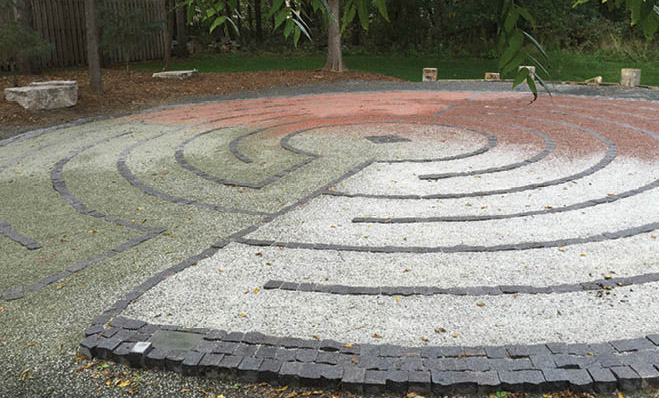The earliest labyrinths, dating back 4,000 years or more, were symbols in rock carvings. Unlike mazes with multiple paths and dead ends, labyrinths consist of one path from beginning to end.
Today, they are walked and often used to meditate, pray, problem solve or simply used for fun. And lucky for us, we don’t have to travel far to experience them.
“The Twin Cities area is labyrinth-rich,” says Lisa Gidlow Moriarty, a Stillwater-based labyrinth designer and owner of Paths of Peace Labyrinths & Resources. Here, labyrinths can be found in schools, churches, hospitals, retirement communities, parks and even White Bear Center for the Arts (WBCA).
Staff at the WBCA was inspired to add a labyrinth as yet another beautiful element to its impressive facility, but needed some artistic help; that responsibility was left to Gidlow Moriarty. Together, Gidlow Moriarty and the WBCA’s executive director Suzi Hudson explored different labyrinth patterns that fit into the landscape.
The Design
Ultimately, the duo chose a medieval-style labyrinth pattern, which turns 180 degrees when it reaches one quarter or halfway around the pattern, thus forming quadrants. The quadrants in WBCA’s labyrinth were uniquely created using four different colors of crushed granite, each color representing one of the four seasons.
“The different colors and textures of the White Bear Center for the Arts labyrinth allows each person who walks the labyrinth to incorporate color, texture and symbolism into their experience in whatever manner is desired,” Gidlow Moriarty says. “Everyone is free to use their own interpretation, depending on what is personally meaningful.”

The Process
Once the design was complete, it was time to get the labyrinth installed. And with a cadre of enthusiastic volunteers, installation only took three days. Gidlow Moriarty and her partner constructed the center and entrance paths before turning the work over to the helpers. The granite stones were carried and set down in the space indicated by the layout. Then the crushed granite was shoveled in and packed down to create the walking paths.
The End Result
The labyrinth was installed in June 2014, and has been well received by visitors. “It has been very beneficial to have a place that people want to come and enjoy,” says Danielle Cézanne, program director at WBCA.
All of this hard work culminates into a personal takeaway for everyone who walks the sacred path. “Each person will individually experience the labyrinth walk, and each experience may be different than the last,” says Gidlow Moriarty. “Because the White Bear Center for the Arts labyrinth is a public space, people will use it for many different reasons. Some may come to walk as a spiritual practice to begin or end their day. Some may visit when they are celebrating a special event or when they are troubled or grieving. Others may walk to focus on an issue, to seek insight or to inspire creativity. The labyrinth is infinitely adaptable.”

Did You Know?
- WBCA’s labyrinth is a piece of public art open for anyone to use at any time.
- Free labyrinth classes are provided by WBCA during warmer months.
- Labyrinths can also be found at White Bear Unitarian Universalist Church in Mahtomedi, Parkview United Church in White Bear Lake and Oneka Elementary School in Hugo.
&
White Bear Center for the Arts
4971 Long Ave.
White Bear Lake
651.407.0596
Paths of Peace Labyrinths & Resources
612.747.7446









